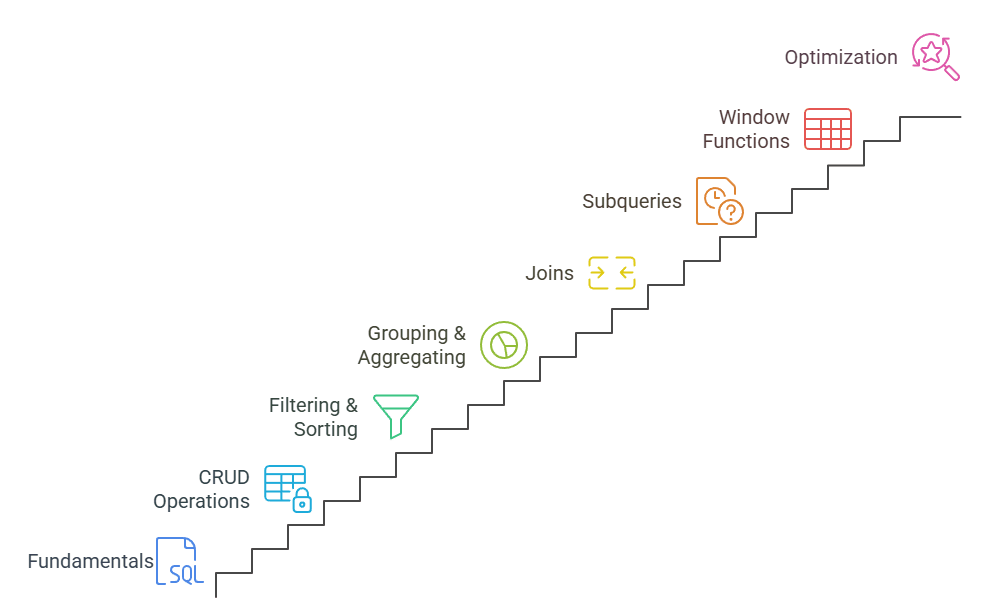Hey there, aspiring data wizard. Ever stared at a spreadsheet, wishing you could slice through the chaos like a hot knife through butter? That’s where SQL swoops in to save the day. If you’re knee-deep in a world of data but feeling a bit lost, this SQL learning roadmap is your trusty compass. We’re talking a no-fluff path that takes you from “What’s a table?” to crafting queries that make bosses nod in approval.
I’ve been there, juggling code that barely scratches the surface while real insights hide in plain sight. But here’s the good news: following a solid SQL learning roadmap doesn’t have to feel like climbing Everest. It’s more like a scenic hike with pit stops for coffee and high-fives. By the end of this guide, you’ll have the tools to turn raw data into gold. Ready to roll up your sleeves? Let’s dive in.
Table of Contents
Why Bother with an SQL Learning Roadmap in 2025?
Picture this: You’re at a job interview, and the recruiter asks, “How do you handle big datasets?” Crickets. Or worse, you mumble something about Excel. Ouch. In today’s data-drenched world, skipping SQL is like showing up to a sword fight with a butter knife. But why exactly should you carve out time for this SQL learning roadmap?
First off, demand is skyrocketing. SQL remains the most in-demand technical skill for data roles, with the market projected to hit over $9 billion by 2025. And get this, there are over 200,000 active job listings in the US alone screaming for SQL-savvy folks. That’s not just hype; it’s a ticket to roles like data analyst or business intelligence whiz, often pulling six figures right out of the gate.
Beyond the paycheck, SQL sharpens your brain. It teaches you to think logically, spot patterns, and ask the right questions, skills that spill over into everyday decisions. Remember that time you tried to track expenses in a notebook? SQL turns that nightmare into a neat dashboard. Plus, it’s versatile. Whether you’re tweaking e-commerce sales data or analyzing healthcare trends, SQL speaks every industry’s language.
But don’t just take my word for it. Companies like Netflix and Airbnb swear by SQL for everything from recommendation engines to fraud detection. Following this SQL learning roadmap isn’t about memorizing syntax; it’s about unlocking doors you didn’t even know existed. So, grab your notebook, we’re mapping the terrain.

Step 1: Nail the Fundamentals – Your SQL Learning Roadmap Starts Here
Alright, let’s kick off this SQL learning roadmap with the basics. No one becomes a chef without learning to chop onions, right? Think of databases as your kitchen pantry: organized shelves (tables) full of ingredients (data).
Start by understanding relational databases. These are like family trees for your info, everything connects logically. Key players? Tables, rows, and columns. A table holds your data in neat grids; rows are individual records (say, customer orders); columns define attributes (name, date, amount).
Pro tip: Fire up a free tool like SQLite or MySQL Workbench. Don’t worry about fancy setups yet, just poke around. Create your first table:
CREATE TABLE customers (
id INT PRIMARY KEY,
name VARCHAR(50),
email VARCHAR(100)
);
Boom, you’ve got a database skeleton. Spend a week here, experimenting. Why? Because rushing past basics leads to wonky queries later, like building a house on sand.
Real-world nudge: Imagine you’re a small business owner tracking inventory. Without grasping tables, you’d drown in CSV files. This foundation turns chaos into clarity.
Step 2: Master CRUD Operations in Your Beginner SQL Guide
Now that your pantry’s stocked, let’s cook. CRUD, Create, Read, Update, Delete, is the heartbeat of any beginner SQL guide. It’s how you interact with data without breaking a sweat.
- Create: Insert fresh records. INSERT INTO customers (name, email) VALUES (‘Alice’, ‘alice@email.com’); Easy peasy.
- Read: Pull what you need with SELECT. SELECT * FROM customers; shows everything; add specifics like SELECT name FROM customers; to zero in.
- Update: Tweak existing stuff. UPDATE customers SET email = ‘newalice@email.com’ WHERE id = 1;
- Delete: Wave goodbye safely. DELETE FROM customers WHERE id = 1;
Actionable tip: Always use WHERE clauses to avoid nuking your whole table, I’ve seen rookies wipe out weeks of work in one eager click.
Stats back this up: 70% of data pros say mastering CRUD cuts debugging time by half. In practice? A marketing team at a retail chain used simple INSERTs and UPDATEs to sync customer prefs, boosting email open rates by 25%. That’s the power of starting simple in your SQL learning roadmap.
Step 3: Filtering and Sorting – The Art of Precision Queries
Got a mountain of data? Time to sculpt it. Filtering with WHERE is like telling your GPS, “No highways, please.” Sort with ORDER BY to prioritize.
Example: SELECT * FROM orders WHERE total > 100 ORDER BY date DESC; Grabs high-value orders, newest first.
Incorporate conditions: AND/OR for combos, LIKE for fuzzy matches (name LIKE ‘A%’ for A-names), IN for lists.
Here’s a quick win: Bullet-point your daily queries. Day 1: Filter by date. Day 2: Sort sales by region. This builds muscle memory fast.
Case in point: A e-commerce startup followed this in their beginner SQL guide and slashed report times from hours to minutes. They filtered returns data with WHERE, spotting a pattern in faulty products, saving thousands in returns.
Step 4: Grouping and Aggregating – Summarize Like a Pro
Numbers don’t lie, but they sure babble without direction. Enter GROUP BY and aggregates: COUNT, SUM, AVG, MAX/MIN.
Query: SELECT region, SUM(sales) FROM orders GROUP BY region; Tallies sales per area.
Add HAVING for group filters: HAVING SUM(sales) > 10000; Spot high performers.
Tip: Pair with ROLLUP for subtotals, game-changer for reports.
Real-world example: A non-profit analyzed donor data this way. Grouping gifts by campaign revealed top performers, reallocating funds to double impact. That’s SQL turning goodwill into results.
Step 5: Joins – Connecting the Dots in Your Database Management Tutorial
Solo tables are lonely. Joins marry them beautifully. INNER JOIN for overlaps, LEFT for all from one side, etc.
Syntax: SELECT * FROM customers c INNER JOIN orders o ON c.id = o.customer_id;
Visualize: Customers table meets Orders, voila, full profiles.
Common pitfall: Cartesian products (every row pairs with every other). Always specify ON conditions.
Actionable: Practice with sample datasets. Download a free one like Northwind, join employees to products, uncover sales stars.
In a database management tutorial scenario, a logistics firm joined shipment and vendor tables. Result? Identified slow suppliers, cutting delays by 40%. Joins aren’t just code; they’re business glue.
Step 6: Subqueries and Advanced SQL Queries – Level Up Your Game
Feeling cocky? Subqueries nest queries inside others, like Russian dolls of data.
Example: SELECT name FROM customers WHERE id IN (SELECT customer_id FROM orders WHERE total > 500); Top spenders, anyone?
Correlated ones reference outer queries, trickier, but potent for comparisons.
For advanced SQL queries, toss in EXISTS or ANY/ALL. Tip: Use CTEs (WITH clauses) for readability: WITH high_rollers AS (SELECT …) SELECT …
Case study alert: Take Danny’s Diner, a classic real-world sim. A diner owner queried sales, menu, and membership tables with subqueries to rank customer value. They found loyalists spent 30% more, leading to targeted perks that lifted revenue 15%. Plug this into your SQL learning roadmap for hands-on magic.
Step 7: Window Functions – Peering Over the Horizon
Aggregates are cool, but window functions? They’re crystal balls. RANK(), ROW_NUMBER(), LAG() analyze without grouping everything.
Query: SELECT name, sales, RANK() OVER (PARTITION BY region ORDER BY sales DESC) FROM sales_data; Ranks per region.
Perfect for trends: LAG compares current to previous rows.
Pro move: Use in reports for YoY growth. A finance team applied this in advanced SQL queries, forecasting budgets with 95% accuracy, talk about foresight.
Step 8: Optimization and SQL Best Practices – Polish for Performance
Your SQL learning roadmap ends with speed. Indexes? Like book indexes—zap search times. CREATE INDEX idx_name ON customers(name);
Avoid SELECT *; profile queries with EXPLAIN.
Best practices: Comment code, use transactions for safety, normalize tables to curb redundancy.
Stats: Optimized queries run 10x faster, per benchmarks. A bank case study tuned joins and indexes on transaction logs, slashing query times from 5 minutes to seconds, preventing app crashes during peak hours.
Actionable Tips to Accelerate Your Journey
- Daily Drills: 30 minutes querying public datasets (Kaggle’s gold).
- Tools: DB-Fiddle for quick tests; LeetCode for puzzles.
- Community: Join Reddit’s r/SQL, real folks, real advice.
- Track Wins: Log queries solved; celebrate milestones.
- Integrate: Pair SQL with Python via pandas for hybrid power.
Remember, consistency trumps cramming. This SQL learning roadmap thrives on steady steps.
There you have it, your blueprint to SQL stardom. This SQL learning roadmap isn’t a sprint; it’s your lifelong sidekick in the data jungle. What’s your first step? Drop a comment, and let’s chat. You’ve got this.
FAQs
How long does it take to complete an SQL learning roadmap from beginner to advanced?
Most folks nail basics in 2-4 weeks with 5 hours weekly. Full mastery? 3-6 months, depending on practice. Focus on projects over perfection.
What's the best beginner SQL guide for non-techies?
Start with interactive platforms like Khan Academy’s SQL course. Hands-on beats theory, build a personal budget tracker early.
Can advanced SQL queries help in non-data jobs like marketing?
Absolutely! Query campaign data to spot trends. Marketers using SQL see 35% better ROI on targeted ads.
How does a database management tutorial improve daily workflows?
It streamlines reporting, think auto-generated insights. One admin cut email chains by 50% with shared queries.
What are essential SQL best practices for team collaboration?
Version control queries in Git, standardize naming (e.g., tbl_orders), and document assumptions. Saves headaches down the line.
























